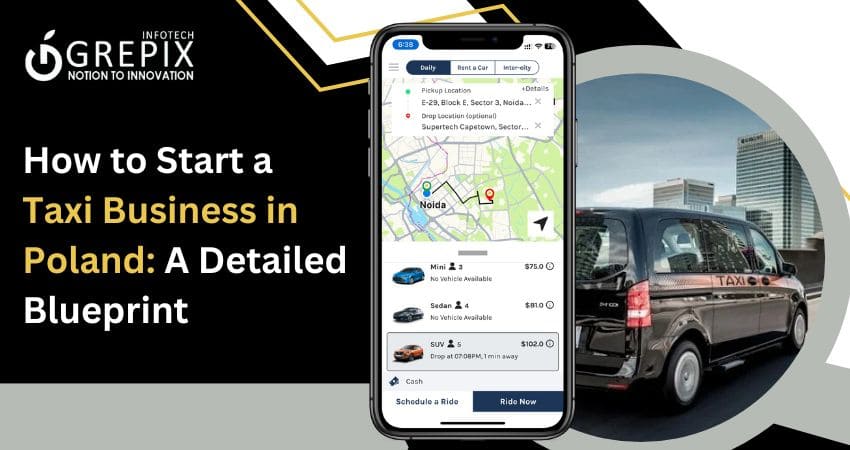How to Start a Taxi Business in Poland: A Detailed Blueprint
If you’ve ever considered starting a taxi business in Poland, you’re not alone. With a growing economy and bustling cities like Warsaw, Krakow, and Gdansk, the demand for reliable transportation is on the rise. Whether you aim to run a traditional taxi service or partner with ride-hailing platforms like Uber and Bolt, the Polish taxi market holds immense potential.
Launching a taxi business in Poland requires careful planning, dedication, and a clear understanding of the market. From securing licenses to building a strong online presence, every step plays a crucial role in ensuring your success. By focusing on customer satisfaction, operational efficiency, and sustainability, you can build a profitable and long-lasting business.
But how do you get started? From legal formalities to creating a business plan, this guide walks you through everything you need to know about launching a successful taxi business in Poland.
Starting a taxi business in Poland offers immense potential due to the growing economy, urbanization, and rising transportation demand in cities like Warsaw and Krakow. Success requires careful planning, including obtaining licenses, meeting vehicle regulations, and creating a solid business plan. Understanding the competition between traditional taxis and ride-hailing platforms like Uber is crucial to carving out a niche. With a focus on customer satisfaction, operational efficiency, and leveraging technology, you can build a thriving business. Grepix Infotech provides innovative taxi app solutions to streamline your operations and help you establish a successful, modern taxi service in Poland.
1 Understanding the Taxi Market in Poland
Current Trends in the Polish Taxi Industry
The taxi industry in Poland is thriving, with increasing urbanization and tourism driving demand. Ride-hailing platforms such as Uber, Bolt, and Free Now dominate urban areas, but traditional taxi services still have their niche. Customers often prefer taxis for their reliability, especially in regulated cities.
Competition Analysis: Traditional Taxis vs. Ride-Sharing Platforms
Competition is stiff. While ride-sharing platforms are popular for their convenience and app-based services, traditional taxis benefit from regulated pricing and customer trust. Understanding the advantages of each model is key to carving out your own space in the market.
Identifying Your Target Market in Poland
Who will you serve? Airport transfers, business professionals, tourists, or locals? Identifying your target demographic will influence your marketing strategies, pricing, and fleet selection.
2 Legal and Regulatory Requirements
Business Registration in Poland
Before operating, you must register your business with the Central Register of Economic Activity (CEIDG) or the National Court Register (KRS). This includes obtaining an NIP (tax identification number) and a REGON (statistical number).
Taxi License Requirements
Running a taxi in Poland requires a taxi license issued by the local municipal office. Here’s what you’ll need:
- A valid driver’s license
- Vehicle registration documents
- Proof of insurance
- A criminal background check
The process varies by city, so check with your local authority.
Understanding Local Laws and Permits
Poland has specific rules about fares, meters, and even car signage for taxis. Familiarize yourself with these regulations to avoid penalties.
Vehicle Regulations for Taxis in Poland
Your vehicle must meet certain standards, including emissions compliance, safety inspections, and appropriate markings (such as a roof-mounted taxi light). Regular inspections are mandatory to maintain your license.
3 Creating a Business Plan
Importance of a Solid Business Plan
A business plan isn’t just a formality—it’s your roadmap to success. It helps you stay organized, secure funding, and set clear goals.
Key Components of a Taxi Business Plan
- Financial Planning: Outline your startup costs, operational expenses, and expected revenue.
- Marketing Strategies: Detail how you’ll attract and retain customers.
- Defining Business Goals: Set measurable targets, like the number of daily rides or revenue milestones.
4 Financial Planning and Funding Options
Estimating Initial Costs
Starting a taxi business has notable expenses, including purchasing or leasing vehicles to build your fleet, securing licenses and permits to comply with regulations, obtaining comprehensive insurance for protection, and investing in branding and marketing to attract and retain customers. Proper planning is key to managing these costs effectively.
Funding Your Business
Consider these options to finance your taxi business venture: Utilize personal savings to maintain full ownership and control, explore small business loans from Polish banks for accessible funding, or partner with investors to share financial risks and resources. Each option offers unique benefits tailored to your goals.
Managing Cash Flow and Profitability
Track your income and expenses meticulously. Use accounting software to ensure your business remains profitable.
5 Fleet Selection and Management
Choosing the Right Vehicles for Your Taxi Business
Your fleet is your backbone. Choose vehicles that are fuel-efficient, reliable, and comfortable. Popular models in Poland include Skoda, Toyota, and Volkswagen.
New vs. Used Cars: Pros and Cons
New cars offer reliability but are costlier upfront, while used cars are cheaper but may require more maintenance. Evaluate your budget before deciding.
Maintenance and Insurance Requirements
Regular vehicle maintenance is crucial for customer safety and satisfaction. Comprehensive insurance is mandatory in Poland and should cover accidents, theft, and damage.
6Hiring and Training Drivers
Recruitment Process for Taxi Drivers in Poland
Finding the right drivers is critical to the success of your taxi business. The ideal candidate should have a valid Polish driver’s license, a clean driving record, and a good understanding of local routes. Advertise job openings on local job boards, social media platforms, or through word-of-mouth to attract skilled drivers.
The interview process should assess their driving skills, professionalism, and customer service capabilities. To further guarantee passenger safety and adherence to Polish laws, think about conducting background checks.
Training Drivers to Meet Industry Standards
Once hired, it’s essential to train your drivers. Guide them on local traffic laws, customer interaction, and safety protocols. Emphasize punctuality, politeness, and problem-solving skills to help your drivers stand out.
Investing in professional training programs or workshops can also improve driver efficiency. Topics like fuel-efficient driving, handling customer complaints, and operating GPS systems can add significant value.
Ensuring Customer Service Excellence
A pleasant experience can turn one-time passengers into loyal customers. Train drivers to maintain a clean and comfortable vehicle, greet passengers courteously, and address concerns promptly. Encourage drivers to go the extra mile—literally and figuratively—to enhance the customer experience.
7 Building an Online Presence
Importance of a Strong Digital Presence
In today’s tech-savvy world, being online isn’t optional—it’s necessary. Customers will likely search for taxi services online or through apps, so a strong digital footprint can help your business grow faster.
Creating a User-Friendly Website
Your website should include key details to attract and inform customers, such as the services you offer, transparent pricing, easy-to-find contact information, and a seamless online booking option. A professional, user-friendly website is essential for building trust and convenience.
Make it mobile-friendly, as most users in Poland search for services via smartphones. Including testimonials and reviews can also boost credibility.
Leveraging Social Media and Online Marketing
Social media platforms like Facebook, Instagram, and Twitter are great for promoting your taxi service. Share updates, promotions, and customer success stories to engage your audience. Use paid ads to target specific demographics like tourists, business professionals, or locals.
Also Read: "Top Ride-Sharing Apps Revolutionizing Transportation in Poland"
8 Setting Up Operations
Establishing an Office and Dispatch System
An office serves as the operational hub for your taxi business. Equip it with essential tools such as computers, phones, and booking software to handle customer inquiries and manage drivers efficiently.
A reliable dispatch system is also crucial. Whether it’s phone-based or app-integrated, it should allow you to assign rides quickly and track vehicles in real-time.
Implementing GPS and Tracking Systems
Install GPS systems in all your vehicles to monitor their location and ensure timely pickups. This not only improves efficiency but also reassures customers about their safety. Advanced systems can even provide traffic updates and suggest the quickest routes.
Creating a Customer Support System
Strong customer support can set your business apart. Offer multiple channels for customers to reach you, including phone, email, and live chat. Address complaints promptly and use feedback to improve your services.
9 Marketing and Growing Your Business
Advertising Strategies for Taxi Services in Poland
Effective advertising can attract more customers to your business. Some ideas include:
- Distributing flyers at airports, hotels, and tourist spots
- Radio or newspaper ads to reach a local audience
- Promotional discounts for first-time users
Loyalty Programs and Customer Retention
Encourage repeat business by introducing loyalty programs. Offer discounts, free rides, or special perks to frequent customers. Simple gestures like sending birthday discounts can also make customers feel valued.
Collaborating with Local Businesses and Hotels
Partner with hotels, restaurants, and event organizers to generate consistent ride bookings. Offer commission-based incentives to these businesses for every customer they refer.
10 Managing Challenges in the Taxi Business
Addressing Competition from Ride-Hailing Services
Competing with giants like Uber and Bolt can be tough, but it’s not impossible. Focus on providing exceptional customer service, transparent pricing, and reliable pickups to differentiate your business. Highlight unique selling points, like fixed fares or 24/7 availability, to attract customers.
Navigating Fuel Price Fluctuations and Operational Costs
Fuel costs can be unpredictable, so consider implementing fuel-efficient driving techniques or transitioning to hybrid or electric vehicles. Optimize routes and monitor expenses closely to minimize operational costs.
Ensuring Compliance with Changing Regulations
The taxi industry in Poland is heavily regulated, and laws can change frequently. Stay informed by joining local taxi associations or subscribing to industry newsletters. Compliance not only avoids fines but also builds trust with your customers.
11 Scaling Your Business
Expanding Your Fleet and Services
As your business grows, consider adding more vehicles to your fleet or introducing new services like airport transfers or corporate packages. Expanding to nearby cities can also increase your market reach.
Diversifying Into Related Business Opportunities
Explore opportunities like leasing vehicles to other taxi operators, providing driver training services, or launching your ride-hailing app. Diversification not only boosts revenue but also reduces risks.
Conclusion
Starting a taxi business in Poland is a rewarding opportunity in a growing market. With careful planning, attention to legal requirements, and a strong focus on customer satisfaction, your business can thrive in Poland’s competitive transportation landscape. Leveraging technology and innovative marketing strategies will further position your services for long-term success.
At Grepix Infotech, we specialize in taxi app development, offering cutting-edge solutions to help you build a modern and efficient transportation business. Whether you're launching a traditional taxi service or a ride-hailing platform, our expertise ensures a seamless and user-friendly experience for your customers. Partner with Grepix to transform your vision into reality and drive your business toward sustainable growth. Let’s build the future of your taxi business —together!
FAQs
1. What are the startup costs for a taxi business in Poland?
Startup costs typically range from PLN 50,000 to PLN 150,000, depending on fleet size and vehicle type.
2. How long does it take to get a taxi license in Poland?
The licensing process can take 2-3 months, depending on the city and required documentation.
3. Can foreigners start a taxi business in Poland?
Yes, foreigners can start a taxi business in Poland, provided they meet all legal requirements.
4. Are there government grants available for taxi businesses in Poland?
Some grants and subsidies may be available, especially for eco-friendly businesses. Check with local authorities for details.
5. How can I compete with ride-hailing platforms like Uber and Bolt?
Focus on customer service, transparent pricing, and offering unique benefits like loyalty programs or fixed fares.
Looking out to start your own venture like Uber? Try out our HireMe Taxi Uber Clone, the easiest way to kick-start your taxi business.








